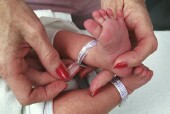- Skip Storing This Everyday Product in the Fridge Door
- Green Tea + B3 Pairing May Boost Brain Health
- Navigating Your Midlife Crisis: Embracing New Possibilities
- City Raccoons Showing Signs of Domestication
- Mapping the Exposome: Science Broadens Focus to Environmental Disease Triggers
- One Week Less on Social Media Linked to Better Mental Health
- Your Brain Changes in Stages as You Age, Study Finds
- Some Suicide Victims Show No Typical Warning Signs, Study Finds
- ByHeart Formula Faces Lawsuits After Babies Sickened With Botulism
- Switch to Vegan Diet Could Cut Your Greenhouse Gas Emissions in Half
Small Childbirth Change Might Help Prevent Iron Deficiency in Babies: Study


Changing how newborns are held immediately after birth could boost the use of delayed cord clamping and potentially reduce the number of infants with iron deficiency, according to a new study.
Waiting until about two minutes after birth to clamp the umbilical cord allows more blood to pass from the mother’s placenta to the baby, which lowers the risk of iron deficiency during infancy, previous research has found.
Current guidelines suggest that the baby be held at the level of the mother’s placenta before the umbilical cord is clamped. However, this position is awkward and uncomfortable for the person holding the newborn, and it hampers immediate contact between the baby and mother, the researchers noted.
These problems could contribute to low rates of delayed clamping, resulting in increased numbers of infants with iron deficiency, the researchers suggested.
This new study in Argentina looked at how changing the position in which babies are held immediately after birth affected the use of delayed cord clamping. It included 197 babies who were held in the currently recommended position and 194 who were instead immediately placed on the mother’s stomach or chest.
Both groups of babies had similar volumes of blood transferred from the mother’s placenta. This means that placing the baby on the mother’s stomach or chest was as effective as the more awkward currently recommended position, according to the study appearing April 16 in The Lancet.
“Iron deficiency in newborn babies and children is a serious public health problem in low-income countries, and also prevalent in countries from North America and western Europe,” lead author Nestor Vain, of the Foundation for Maternal and Child Health in Buenos Aires, said in a journal news release.
“Our study suggests that when umbilical cord clamping is delayed for two minutes, holding the baby on the mother’s chest or abdomen is no worse than the currently recommended practice of holding the baby below this level,” Vain said.
“Because of the potential of enhanced bonding between mother and baby, increased success of breast-feeding and the compliance with the procedure, holding the infant by the mother immediately after birth should be strongly recommended,” he added.
Dr. Tonse Raju, of the U.S. National Institute of Child Health and Human Development, wrote an accompanying journal commentary.
This study “should bring a sigh of relief from those trying to incorporate delayed umbilical cord clamping into practice,” Raju wrote. “The results are convincing and show that gravity did not have an effect on volume of placental transfusion.”
More information
The U.S. National Library of Medicine has more about childbirth.
Source: HealthDay
Copyright © 2025 HealthDay. All rights reserved.










